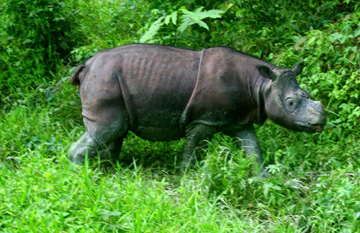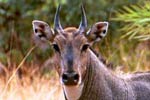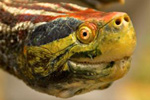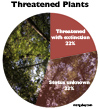Researchers have developed a new method to predict how close species are to extinction. Dubbed SAFE (Species Ability to Forestall Extinction) the researchers believe the new tool, published in the Frontiers in Ecology and Environment, should help conservationists select which species to focus on saving and which, perhaps controversially, should be let go.
“The idea is fairly simple—it’s the distance a population is (in terms of abundance) from its minimum viable population size. While we provide a formula for working this out, it’s more than just a formula—we’ve shown that SAFE is the best predictor yet of the vulnerability of mammal species to extinction,” co-author Professor Corey
Bradshaw, Director of Ecological Modeling at the University of Adelaide’s Environment Institute, says in a press release.
The authors say that the index is not necessarily meant to be a replacement to the International Union for Conservation of Nature (IUCN) Red List of Threatened Species but a tool to use alongside. However, the SAFE index did prove to be a better predictor of extinction threat than another approach of looking at the percentage species’ habitat loss.
 Researchers estimate that 250 Sumatran rhino survive in the world. This captive individual in Sabah, Malaysia is a subspecies known as the Bornean rhino. Photo by: Jeremy Hance. |
“The SAFE index provides a more meaningful and fine-grained interpretation of the relative threat of species extinction than do the IUCN threat categories alone,” the authors write.
Using rhinos as an example, Bradshaw explains: “our index shows that not all Critically Endangered species are equal […] For example, our studies show that practitioners of conservation triage may want to prioritize resources on the Sumatran rhinoceros instead of the Javan rhinoceros. Both species are Critically Endangered, but the Sumatran rhino is more likely to be brought back from the brink of extinction based on its SAFE index.”
The SAFE index team analyzed 95 mammals species and found nearly 60% are close to a ‘tipping point’ that could push the species to extinction, while 25% are worse off and already close to extinction. Such analyses should allow conservationists a better tool to determine where to spend funds and time.
“Conservationists with limited resources may want to channel their efforts on saving the tiger, a species that is at the ‘tipping point’ and could have reasonable chance of survival,” Bradshaw says.
CITATION: Gopalasamy Reuben Clements, Corey JA Bradshaw, Barry W Brook, and William F Laurance. The SAFE index: using a threshold population target to measure relative species threat. Frontiers in Ecology and Environment. 2011. doi:10.1890/100177.
Related articles
Parks key to saving India’s great mammals from extinction
 (02/24/2011) Krithi Karanth grew up amid India’s great mammals—literally. Daughter of conservationist and scientist Dr. Ullas Karanth, she tells mongabay.com that she saw her first wild tigers and leopard at the age of two. Yet, the India Krithi Karanth grew up in may be gone in a century, according to a massive new study by Karanth which looked at the likelihood of extinction for 25 of India’s mammals, including well-known favorites like Bengal tigers and Asian elephants, along with lesser known mammals (at least outside of India) such as the nilgai and the gaur. The study found that given habitat loss over the past century, extinction stalked seven of India’s mammals especially: Asiatic lions, Bengal tigers, wild dogs (also known as dholes), swamp deer, wild buffalo, Nilgiri Tahr, and the gaur. However, increasing support of protected areas and innovative conservation programs outside of parks would be key to saving India’s wildlife in the 21st Century.
(02/24/2011) Krithi Karanth grew up amid India’s great mammals—literally. Daughter of conservationist and scientist Dr. Ullas Karanth, she tells mongabay.com that she saw her first wild tigers and leopard at the age of two. Yet, the India Krithi Karanth grew up in may be gone in a century, according to a massive new study by Karanth which looked at the likelihood of extinction for 25 of India’s mammals, including well-known favorites like Bengal tigers and Asian elephants, along with lesser known mammals (at least outside of India) such as the nilgai and the gaur. The study found that given habitat loss over the past century, extinction stalked seven of India’s mammals especially: Asiatic lions, Bengal tigers, wild dogs (also known as dholes), swamp deer, wild buffalo, Nilgiri Tahr, and the gaur. However, increasing support of protected areas and innovative conservation programs outside of parks would be key to saving India’s wildlife in the 21st Century.
Top 25 most endangered turtles: Asian species in crisis
 (02/23/2011) Surviving hundreds of millions of years on Earth have not saved turtles from facing extinction at human hands. A new report by the Wildlife Conservation Society (WCS) and the Turtle Conservation Coalition, identifies the world’s 25 most imperiled turtles, including one that is practically assured extinction: ‘Lonesome George’ the last Abdington Island tortoise in the world. The list includes four turtle species from South and Central America, three from Africa, and one from Australia. But Asia is the hotbed for turtles in trouble with 17 of the top 25 species, or 68%. The numbers are even more alarming if one looks only at the top ten: eight of the top ten are in Asia, and six of these in China.
(02/23/2011) Surviving hundreds of millions of years on Earth have not saved turtles from facing extinction at human hands. A new report by the Wildlife Conservation Society (WCS) and the Turtle Conservation Coalition, identifies the world’s 25 most imperiled turtles, including one that is practically assured extinction: ‘Lonesome George’ the last Abdington Island tortoise in the world. The list includes four turtle species from South and Central America, three from Africa, and one from Australia. But Asia is the hotbed for turtles in trouble with 17 of the top 25 species, or 68%. The numbers are even more alarming if one looks only at the top ten: eight of the top ten are in Asia, and six of these in China.
Mass extinction fears widen: 22 percent of world’s plants endangered
 (09/28/2010) Scientific warnings that the world is in the midst of a mass extinction were bolstered today by the release of a new study that shows just over a fifth of the world’s known plants are threatened with extinction—levels comparable to the Earth’s mammals and greater than birds. Conducted by the Royal Botanic Gardens, Kew; the Natural History Museum, London; and the International Union for the Conservation of Nature (IUCN), the study is the first time researchers have outlined the full threat level to the world’s plant species. In order to estimate overall threat levels, researchers created a Sampled Red List Index for Plants, analyzing 7,000 representative species, including both common and rare plants.
(09/28/2010) Scientific warnings that the world is in the midst of a mass extinction were bolstered today by the release of a new study that shows just over a fifth of the world’s known plants are threatened with extinction—levels comparable to the Earth’s mammals and greater than birds. Conducted by the Royal Botanic Gardens, Kew; the Natural History Museum, London; and the International Union for the Conservation of Nature (IUCN), the study is the first time researchers have outlined the full threat level to the world’s plant species. In order to estimate overall threat levels, researchers created a Sampled Red List Index for Plants, analyzing 7,000 representative species, including both common and rare plants.







